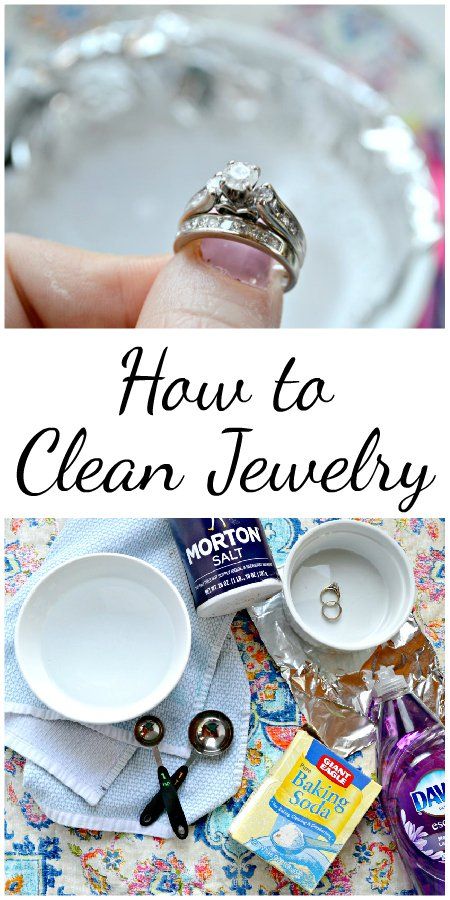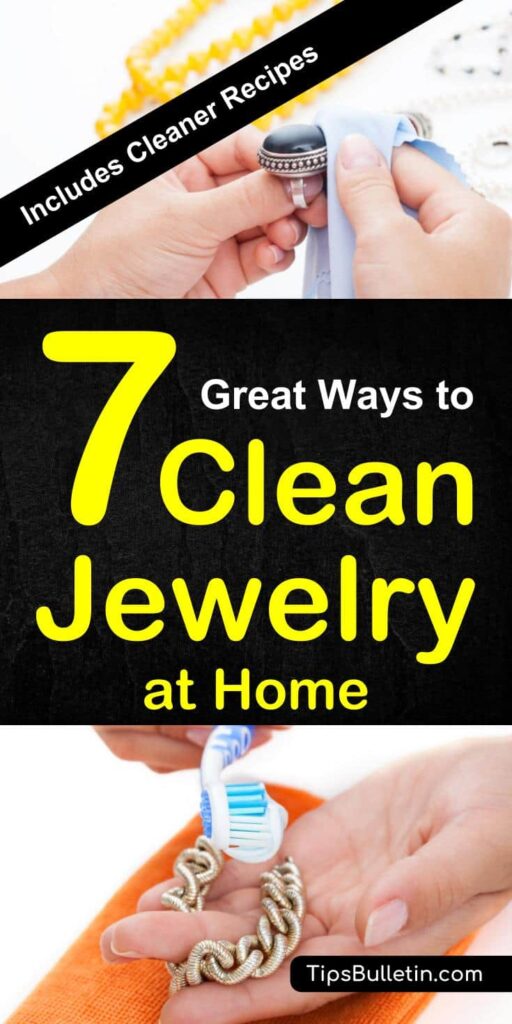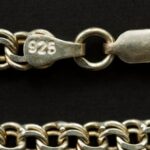Jewelry, those glittering adornments we cherish, often holds sentimental value far beyond their monetary worth. Whether it’s a family heirloom, a gift from a loved one, or a personal treat, keeping your jewelry sparkling requires regular cleaning. Over time, everyday wear exposes jewelry to dirt, oils, lotions, and other substances that can dull its shine. While professional cleaning is an option, it can be costly and time-consuming. Fortunately, many effective and safe cleaning methods can be performed in the comfort of your own home.
The importance of cleaning jewelry regularly goes beyond aesthetics. Accumulated grime can actually damage delicate metals and gemstones over time. For instance, the buildup of lotions and soaps can create a film that scratches softer stones like pearls and opals. Furthermore, dirt can erode the plating on costume jewelry, exposing the base metal and potentially causing allergic reactions. Therefore, a consistent cleaning routine is crucial for preserving the beauty and longevity of your treasured pieces.

In today’s world, where environmental consciousness and cost-effectiveness are highly valued, learning how to clean jewelry at home is more relevant than ever. Many commercial jewelry cleaners contain harsh chemicals that can be harmful to both your jewelry and the environment. By opting for homemade solutions and gentle cleaning techniques, you can minimize your environmental impact while saving money. Moreover, understanding the specific needs of different types of jewelry allows you to tailor your cleaning approach, ensuring optimal results without causing damage.
This comprehensive guide will provide you with the knowledge and tools to confidently clean your jewelry at home, from delicate pearls to durable diamonds. We’ll explore various cleaning solutions, techniques, and precautions to ensure your precious pieces remain sparkling and beautiful for years to come. We’ll also discuss the different types of jewelry and their specific cleaning requirements, empowering you to maintain your collection with ease and expertise. So, let’s embark on this journey to unlock the secrets of at-home jewelry cleaning and restore the brilliance of your cherished possessions.
Understanding Jewelry Cleaning Basics
Before diving into specific cleaning methods, it’s essential to grasp some fundamental principles that apply to all types of jewelry. Proper preparation, gentle techniques, and appropriate cleaning solutions are crucial for achieving optimal results without causing damage. Understanding the composition of your jewelry and the potential effects of different cleaning agents is also paramount. Neglecting these basics can lead to irreversible damage, diminishing the value and beauty of your precious pieces.
Essential Tools and Supplies
Having the right tools and supplies on hand will make the cleaning process more efficient and effective. Here’s a list of essential items:
- Soft-bristled brush: A toothbrush with soft bristles is ideal for gently scrubbing away dirt and grime.
- Mild dish soap: Opt for a gentle, fragrance-free dish soap that won’t damage delicate materials.
- Warm water: Use lukewarm water for cleaning, avoiding extreme temperatures that could harm certain gemstones.
- Soft cloth: A microfiber cloth or a lint-free cotton cloth is perfect for drying and polishing your jewelry.
- Small bowl: Use a bowl to contain the cleaning solution and prevent spills.
- Cotton swabs: Cotton swabs are useful for cleaning hard-to-reach areas and intricate details.
General Cleaning Procedure
While specific cleaning methods vary depending on the type of jewelry, the general procedure remains consistent:
- Prepare the cleaning solution: Mix a few drops of mild dish soap with warm water in a small bowl.
- Soak the jewelry: Immerse the jewelry in the cleaning solution for 10-15 minutes to loosen dirt and grime.
- Gently scrub: Use a soft-bristled brush to gently scrub the jewelry, paying attention to crevices and hard-to-reach areas.
- Rinse thoroughly: Rinse the jewelry thoroughly under warm running water to remove all traces of soap.
- Dry and polish: Pat the jewelry dry with a soft cloth and then gently polish it to restore its shine.
Understanding Different Jewelry Materials
Different types of jewelry require different cleaning approaches. Here’s a breakdown of common jewelry materials and their specific cleaning needs:
- Gold: Gold is relatively durable but can still be scratched by abrasive cleaners. Use a mild dish soap and warm water solution.
- Silver: Silver is prone to tarnishing, which is a natural process caused by exposure to sulfur in the air. Use a silver-specific cleaner or a baking soda paste.
- Diamonds: Diamonds are the hardest gemstone and can withstand most cleaning methods. Use a mild dish soap and warm water solution or a commercial diamond cleaner.
- Pearls: Pearls are delicate and can be damaged by harsh chemicals. Use a mild soap and water solution and avoid soaking them for extended periods.
- Opals: Opals are also delicate and can be damaged by extreme temperatures and harsh chemicals. Use a mild soap and water solution and avoid ultrasonic cleaners.
- Costume Jewelry: Costume jewelry often has a thin plating that can be easily damaged. Use a very mild soap and water solution and avoid abrasive cleaners.
Real-World Examples and Expert Insights
Case Study: A customer brought in a heavily tarnished silver necklace that had been stored in a damp environment for years. Instead of using a harsh chemical cleaner, we opted for a gentle baking soda paste. By applying the paste with a soft cloth and gently buffing the necklace, we were able to remove the tarnish without damaging the silver. This case highlights the importance of choosing the right cleaning method based on the specific needs of the jewelry.
Expert Insight: According to renowned jewelry expert, Sarah Thompson, “Regular cleaning is essential for maintaining the beauty and longevity of your jewelry. However, it’s crucial to understand the specific needs of each piece and choose the appropriate cleaning method. Avoid using harsh chemicals or abrasive cleaners, as these can damage delicate materials.”
Specific Cleaning Methods for Different Jewelry Types
Now that we’ve covered the basics, let’s delve into specific cleaning methods for different types of jewelry. Each material requires a tailored approach to ensure effective cleaning without causing damage. From delicate pearls to resilient diamonds, understanding the unique properties of each material is crucial for maintaining its beauty and value. We’ll explore various cleaning solutions, techniques, and precautions to help you achieve optimal results.
Cleaning Gold Jewelry
Gold jewelry is relatively easy to clean and maintain. Its resistance to tarnish makes it a durable choice for everyday wear. However, gold can still accumulate dirt, oils, and lotions, which can dull its shine. Here’s how to effectively clean your gold jewelry at home:
- Cleaning Solution: Mix a few drops of mild dish soap with warm water.
- Cleaning Procedure: Soak the gold jewelry in the solution for 15-20 minutes. Gently scrub with a soft-bristled brush, paying attention to crevices and intricate details. Rinse thoroughly under warm running water and pat dry with a soft cloth.
- Polishing: For extra shine, use a jewelry polishing cloth specifically designed for gold.
Cleaning Gold Plated Jewelry
Gold plated jewelry requires extra care as the gold plating is thin and can be easily damaged. Avoid abrasive cleaners and harsh scrubbing. Use a very mild soap and water solution and gently pat dry with a soft cloth.
Cleaning Silver Jewelry
Silver is prone to tarnishing, which is a natural process caused by exposure to sulfur in the air. Tarnishing can make silver jewelry look dull and unattractive. Here are several methods for cleaning silver jewelry:
- Baking Soda Paste: Mix baking soda with a small amount of water to form a paste. Apply the paste to the tarnished areas and gently rub with a soft cloth. Rinse thoroughly and pat dry.
- Silver Cleaning Solution: Use a commercially available silver cleaning solution, following the manufacturer’s instructions carefully.
- Aluminum Foil and Baking Soda: Line a glass bowl with aluminum foil and fill it with hot water. Add a tablespoon of baking soda and immerse the silver jewelry in the solution, ensuring it touches the aluminum foil. The tarnish will transfer to the foil. Rinse thoroughly and pat dry.
Preventing Silver Tarnish
To prevent silver tarnish, store your silver jewelry in airtight containers or pouches. You can also place anti-tarnish strips in your jewelry box to absorb sulfur in the air.
Cleaning Diamond Jewelry
Diamonds are the hardest gemstone and can withstand most cleaning methods. However, dirt and grime can still accumulate on the surface, dulling their brilliance. Here’s how to clean your diamond jewelry:
- Cleaning Solution: Mix a few drops of mild dish soap with warm water.
- Cleaning Procedure: Soak the diamond jewelry in the solution for 10-15 minutes. Gently scrub with a soft-bristled brush, paying attention to the setting and any intricate details. Rinse thoroughly under warm running water and pat dry with a soft cloth.
- Commercial Diamond Cleaner: Use a commercially available diamond cleaner, following the manufacturer’s instructions carefully.
Cleaning Pearl Jewelry
Pearls are delicate and can be easily damaged by harsh chemicals and abrasive cleaners. Avoid soaking pearls for extended periods and never use ultrasonic cleaners. Here’s how to clean your pearl jewelry:
- Cleaning Solution: Mix a few drops of mild soap (like baby shampoo) with warm water.
- Cleaning Procedure: Dip a soft cloth in the solution and gently wipe the pearls. Avoid soaking them. Pat dry with a clean, soft cloth.
- Storage: Store pearls separately from other jewelry to prevent scratches.
Cleaning Costume Jewelry
Costume jewelry often has a thin plating that can be easily damaged. Use a very mild soap and water solution and avoid abrasive cleaners. Here’s how to clean your costume jewelry:
- Cleaning Solution: Mix a few drops of mild soap with warm water.
- Cleaning Procedure: Dip a soft cloth in the solution and gently wipe the jewelry. Avoid soaking it. Pat dry with a clean, soft cloth.
- Prevention: To prevent damage, avoid wearing costume jewelry while showering or swimming.
Real-World Examples and Expert Insights
Case Study: A customer accidentally used a harsh silver cleaner on her gold plated bracelet, causing the plating to peel off. This highlights the importance of using the right cleaning method for each type of jewelry.
Expert Insight: According to jewelry designer, Emily Carter, “When cleaning jewelry at home, always start with the gentlest method possible. You can always try a stronger method if the initial cleaning is not effective, but you can’t undo damage caused by harsh chemicals or abrasive cleaners.”
Advanced Cleaning Techniques and Precautions
While basic cleaning methods are effective for removing everyday dirt and grime, some jewelry pieces may require more advanced techniques. This section will cover ultrasonic cleaners, steam cleaners, and other specialized methods, along with essential precautions to ensure the safety of your jewelry. Understanding the potential risks and benefits of these techniques is crucial for making informed decisions about your jewelry cleaning routine.
Using Ultrasonic Cleaners
Ultrasonic cleaners use high-frequency sound waves to create tiny bubbles in a cleaning solution, which then implode and dislodge dirt and grime. While effective for cleaning durable jewelry like diamonds and gold, ultrasonic cleaners can damage delicate materials like pearls, opals, and emeralds. Here are some precautions to consider:
- Suitable Jewelry: Only use ultrasonic cleaners for durable jewelry like diamonds, gold, platinum, and some gemstones.
- Unsuitable Jewelry: Avoid using ultrasonic cleaners for pearls, opals, emeralds, amber, coral, and costume jewelry.
- Cleaning Solution: Use a mild jewelry cleaning solution specifically designed for ultrasonic cleaners.
- Procedure: Follow the manufacturer’s instructions carefully. Do not over-clean jewelry, as prolonged exposure to ultrasonic waves can cause damage.
Using Steam Cleaners
Steam cleaners use pressurized steam to dislodge dirt and grime. They are effective for cleaning diamonds and other durable gemstones, but can damage delicate materials like pearls and opals. Here are some precautions to consider:
- Suitable Jewelry: Only use steam cleaners for durable jewelry like diamonds, gold, and platinum.
- Unsuitable Jewelry: Avoid using steam cleaners for pearls, opals, emeralds, and other delicate gemstones.
- Procedure: Hold the jewelry securely and direct the steam at the areas you want to clean. Avoid prolonged exposure to steam.
Dealing with Stubborn Stains and Tarnish
Sometimes, basic cleaning methods are not enough to remove stubborn stains and tarnish. Here are some alternative solutions:
- Ammonia Solution: For heavily tarnished silver, you can use a diluted ammonia solution. Mix one part ammonia with six parts water. Soak the silver jewelry for no more than 30 minutes. Rinse thoroughly and pat dry. Caution: Do not use ammonia on gold, pearls, or other delicate materials.
- Toothpaste: For stubborn stains on diamonds, you can use a small amount of non-gel toothpaste. Gently rub the toothpaste onto the diamond with a soft-bristled brush. Rinse thoroughly and pat dry. Caution: Avoid using toothpaste on gold, silver, pearls, or other delicate materials.
Preventive Measures for Jewelry Care
Preventing dirt and grime from accumulating on your jewelry is the best way to keep it clean and sparkling. Here are some preventive measures you can take:
- Remove Jewelry Before Activities: Remove your jewelry before showering, swimming, exercising, or doing household chores.
- Avoid Contact with Chemicals: Avoid contact with harsh chemicals like chlorine, bleach, and hairspray.
- Store Jewelry Properly: Store your jewelry in airtight containers or pouches to protect it from dust, moisture, and tarnish.
- Regular Cleaning: Clean your jewelry regularly to prevent the buildup of dirt and grime.
Real-World Examples and Expert Insights
Case Study: A customer used an ultrasonic cleaner on her pearl necklace, causing the pearls to crack and lose their luster. This underscores the importance of knowing which cleaning methods are safe for different types of jewelry.
Expert Insight: According to gemologist, David Miller, “Ultrasonic cleaners and steam cleaners can be effective for cleaning certain types of jewelry, but they should be used with caution. Always research the specific cleaning needs of each piece of jewelry before attempting any advanced cleaning techniques.”
Summary: Keeping Your Jewelry Sparkling
Maintaining the brilliance of your jewelry doesn’t require expensive professional cleaning services. With the right knowledge and tools, you can effectively clean your precious pieces at home, preserving their beauty and value for years to come. This guide has provided a comprehensive overview of jewelry cleaning, covering everything from essential tools and supplies to specific cleaning methods for different materials. Remember, the key to successful at-home jewelry cleaning is understanding the unique properties of each piece and choosing the appropriate cleaning technique.
We began by emphasizing the importance of regular jewelry cleaning, not only for aesthetic reasons but also for preventing damage to delicate metals and gemstones. We discussed the essential tools and supplies needed for at-home cleaning, including soft-bristled brushes, mild dish soap, warm water, and soft cloths. The general cleaning procedure involves preparing a cleaning solution, soaking the jewelry, gently scrubbing, rinsing thoroughly, and drying and polishing.
Next, we explored specific cleaning methods for different types of jewelry, including gold, silver, diamonds, pearls, and costume jewelry. Each material requires a tailored approach to ensure effective cleaning without causing damage. For gold jewelry, a mild dish soap and warm water solution is typically sufficient. Silver jewelry, prone to tarnishing, can be cleaned with baking soda paste or commercially available silver cleaners. Diamonds, being the hardest gemstone, can withstand most cleaning methods, while pearls require gentle cleaning with mild soap and water. Costume jewelry, with its thin plating, requires extra care and should be cleaned with a very mild solution.
We also delved into advanced cleaning techniques, such as using ultrasonic cleaners and steam cleaners. While effective for certain types of jewelry, these methods can be harmful to delicate materials and should be used with caution. We discussed precautions to consider when using these techniques and provided alternative solutions for dealing with stubborn stains and tarnish. Finally, we emphasized the importance of preventive measures, such as removing jewelry before activities that could expose it to dirt and chemicals, storing it properly, and cleaning it regularly.
By following the guidelines outlined in this guide, you can confidently clean your jewelry at home and maintain its sparkling appearance. Remember to always start with the gentlest method possible and research the specific cleaning needs of each piece before attempting any advanced cleaning techniques. With a little care and attention, your jewelry will continue to shine and bring you joy for many years to come.
Frequently Asked Questions (FAQs)
How often should I clean my jewelry?
The frequency of cleaning depends on how often you wear your jewelry and the type of activities you engage in. For everyday jewelry, cleaning once a month is generally sufficient. However, if you wear your jewelry while exercising, swimming, or doing household chores, you may need to clean it more frequently.
Can I use toothpaste to clean my jewelry?
While toothpaste can be used to clean diamonds, it’s not recommended for other types of jewelry. The abrasive particles in toothpaste can scratch softer metals and gemstones. For gold, silver, pearls, and other delicate materials, use a mild soap and water solution instead.
Is it safe to use ultrasonic cleaners on all types of jewelry?
No, ultrasonic cleaners are not safe for all types of jewelry. They can damage delicate materials like pearls, opals, emeralds, and costume jewelry. Only use ultrasonic cleaners for durable jewelry like diamonds, gold, and platinum.
How can I prevent silver jewelry from tarnishing?
To prevent silver jewelry from tarnishing, store it in airtight containers or pouches. You can also place anti-tarnish strips in your jewelry box to absorb sulfur in the air. Avoid exposing silver jewelry to humidity and harsh chemicals.
What should I do if my jewelry is severely tarnished or stained?
If your jewelry is severely tarnished or stained, you can try using a diluted ammonia solution (for silver only) or a commercial jewelry cleaner. However, if you’re unsure about the best cleaning method, it’s always best to consult with a professional jeweler.



